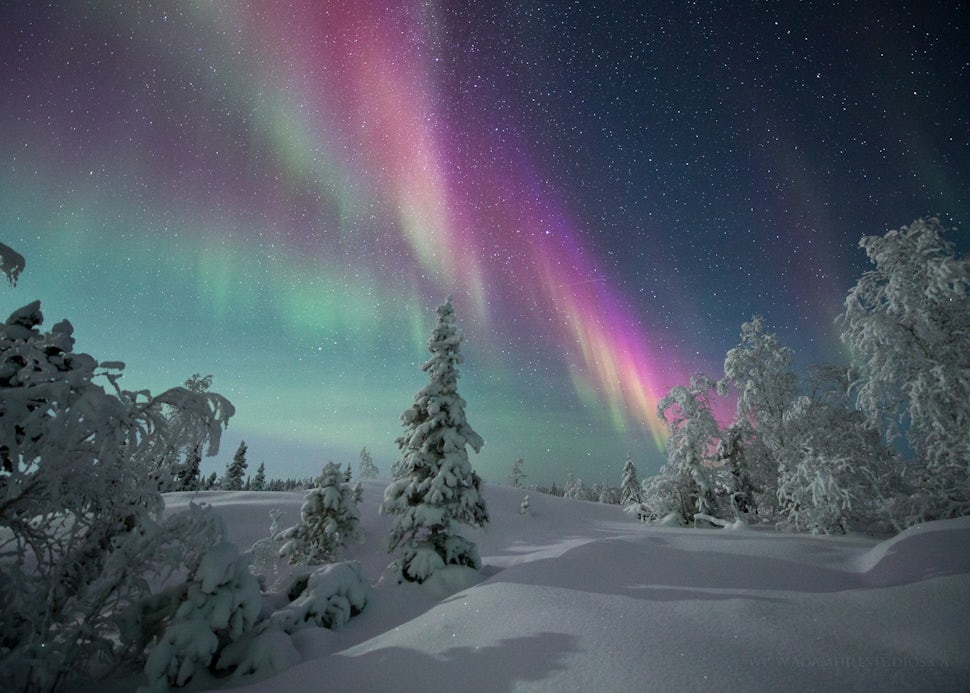Chase the Northern Lights in the Aurora Capital of the World
Aurora Chasing in Yellowknife, NT

Did you know that Yellowknife, Canada is the unofficial “aurora capital of the world?” Geographically, Yellowknife (‘YK’ for short) and surrounding area is perfectly situated under the northern hemisphere’s aurora oval. Although this region of Canada boasts more viewing nights than any other location in the world, it is not a total guarantee that you'll see the lights if you come to Yellowknife. However, your odds of seeing the aurora here are much better than anywhere else in the world. Plus, you can fly directly to YK and have great food and have accommodations!
Solar minimum is coming up and it's the time in the sun's cycle where it has the least amount of storms that cause aurora displays so viewing them in Yellowknife is a good place to hedge your bets.
So how exactly do you chase the aurora? First we need to check two forecasts: the aurora forecast and the weather forecast. Aurora viewing is dependent on high solar activity and clear skies are essential when viewing them. Aurora seems to be more common during the fall and spring equinoxes but they will happen throughout the year (I have photographed the aurora as early as August 4th!). Seeing the aurora in the fall and winter will work more in your favour since there's more hours of darkness in this area of the world hence, making them easier to see. It's always best to get out of town and get on the road when it comes to aurora chasing. There are two roads out of YK, the Ingraham Trail and Highway Three. I personally like going on the Ingraham Trail when I'm in YK. Typically I have a viewing location all to myself and there's really not much chance of light pollution. Don't forget, this area of the world is still fairly wild country so please be aware of your surroundings and going with a friend is always recommended.
Personally when I get ready to chase the aurora, I like to have a few preset ideas or locations in mind so I can pre visualize a few photos that I want. I probably won't get exactly what I'm thinking but it's a great starting point. I'm also not from Yellowknife so I don't know all the great locations like the locals do, but it's hard to take a bad photo of the night sky when in YK. However, I have two recommendations, if you're photographing the lights in the autumn aurora season find a quiet lake and set up there. Use the reflection of the lake water to complete the photo and fill out your foreground. If you're photographing in the winter, look for snow laden/ frost covered trees to help with the photo's foreground. The trees will compliment your aurora photos beautifully.
A lot of people ask for the settings on aurora photos and of course there is no 'one setting' that will always do the best job. There are several factors such as moon light, how fast the aurora is moving, extra colours in the aurora, foreground darkness, how fast your lens is and type of camera you are shooting with which must all be taken in to consideration.
I'll start off with a basic setting, say 10 seconds, f/1.8 at ISO 2000 (it goes without saying that you need a tripod for this stuff, so be sure to bring it). I'll take a few photos to see check my exposure and then I'll adjust based on the movement and brightness of the aurora. If they're slow and somewhat dim, I'll maybe try 15 or 20 seconds and keep my ISO stable or seek to lower it to prevent high ISO noise. If the aurora is quickly shooting across the sky, I'll increase my ISO so I can expose the aurora as fast as possible. I personally love trying to capture the details in the aurora and long exposures will lose these details due to motion blur.
If you're going to Yellowknife for the winter aurora be prepared to get cold. Temperatures at night can easily dip below -40ºC so be sure to get all the wool and down you get your hands on. Get some great boots and gloves so you can manipulate your camera's controls without having to take your gloves off. Keep your camera batteries in pockets next to your skin and be prepared to throw a hand warmer in the pocket with them. The cold is merciless on camera batteries.
There are many resources out there on how to photograph the aurora, and if you have questions post one here in the comments and I'll answer them for you. There are also a number of aurora guides up there and I can recommend the guys at http://aurorachasernorth.com. They know what they're talking about and where to go.
Happy shooting!
We want to acknowledge and thank the past, present, and future generations of all Native Nations and Indigenous Peoples whose ancestral lands we travel, explore, and play on. Always practice Leave No Trace ethics on your adventures and follow local regulations. Please explore responsibly!
Do you love the outdoors?
Yep, us too. That's why we send you the best local adventures, stories, and expert advice, right to your inbox.







